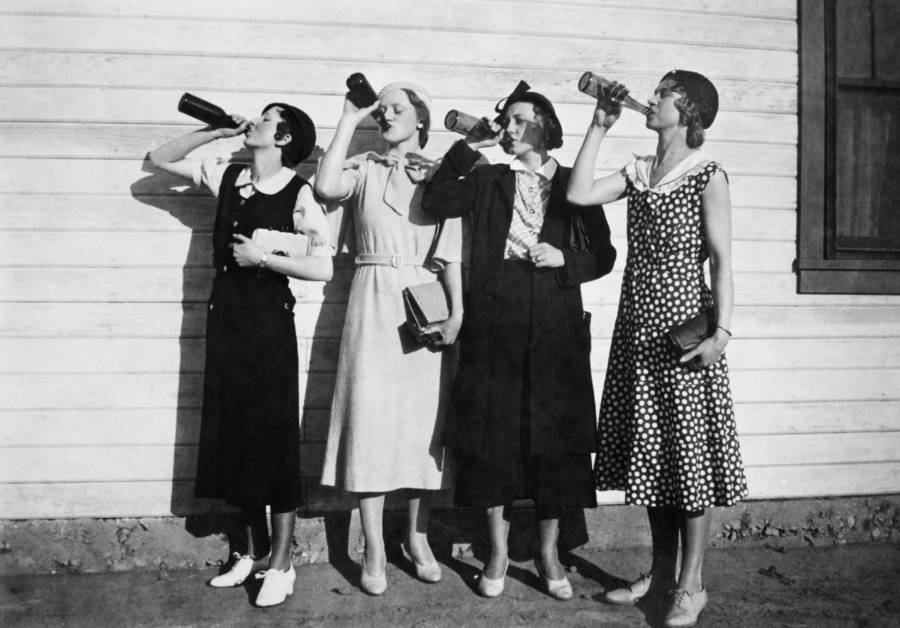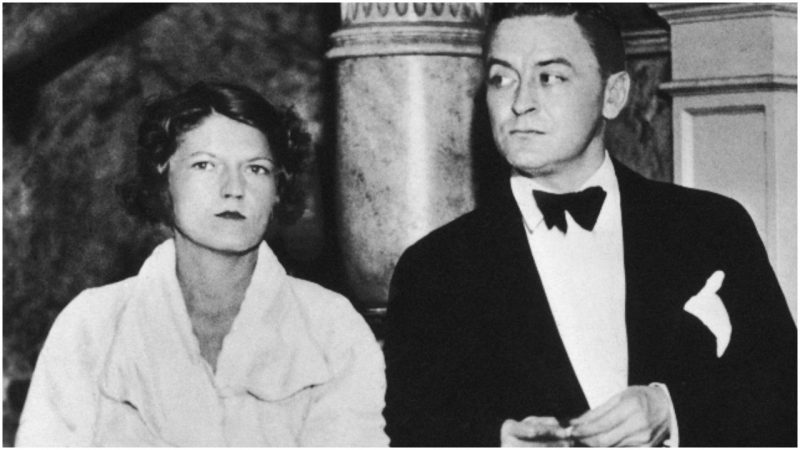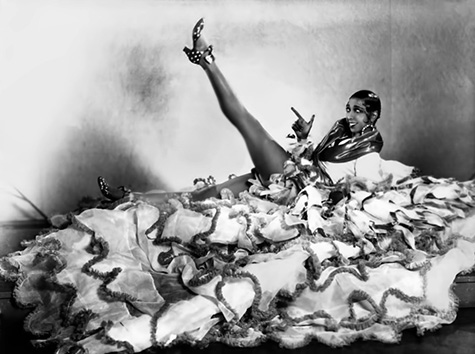 Four women lined up along a wall, chugging bottles of alcohol. Circa 1925.
Four women lined up along a wall, chugging bottles of alcohol. Circa 1925.
 American author F. Scott Fitzgerald attends an event with his wife Zelda, circa 1935. Photo by Pictorial Parade>
American author F. Scott Fitzgerald attends an event with his wife Zelda, circa 1935. Photo by Pictorial Parade>
Zelda Fitzgerald was one of the first women to truly represent the flapper lifestyle in the 1920s through not only her appearance, but in how she lived. She was bold, creative, and was unafraid to stand out in a time when women were expected to stay quiet and submissive. While many knew her as the wife of famous writer F. Scott Fitzgerald, Zelda had a personality and presence that was more than that title. With her bobbed hair, fashionable clothes, and her fun and exciting personality, Zelda was a symbol of the new womanhood forming in the 1920s.
She was often seen dancing at jazz clubs, going to glamorous parties, and speaking her mind about women's independence and creativity, refusing to stay silent or act "ladylike" just to fit in. Zelda broke the rules by embracing independence and freedom, something many women were scared to do before the flapper movement. Even before the word "flapper" became popular, Zelda was already acting like one making her one of the first to embody the spirit of the 1920s modern woman.
What made Zelda stand out even more was her passion for expressing herself. She wrote short stories, painted, and even trained as a ballerina. This showed that flappers weren't just about looks, they were about chasing dreams and finding their own path. Though she often struggled to get credit for her work especially with her husband's fame overshadowing her, she kept pushing to be seen as more than just someone's wife. She wanted to be recognized for her own voice, creativity, and identity.
Zelda Fitzgerald's impact is important because she showed that being a flapper wasn't just a trend, but it was a way of life. She lived freely, challenged expectations, and refused to conform with society's expectations. Through her fearless attitude, personal style, and artistic drive, Zelda helped define what it meant to be a flapper, creating the way for more women to live boldly and authentically.
 Anna May Wong in this 1928 picture. Photograph: Ullstein Bild Accessed April 17 2025
Anna May Wong in this 1928 picture. Photograph: Ullstein Bild Accessed April 17 2025
Anna May Wong was the first Chinese American movie star in Hollywood and a symbol of the Roaring Twenties' flapper culture. Mainstream flappers who were often white women, were celebrated for rejecting traditional gender roles by embracing fashion, short hair, and behavior that pushed the boundaries of social norms. Wong's flapper style still embraced those bold elements like bobbed hair and dramatic makeup, but as a woman of color in Hollywood in a space that often marginalized or stereotyped non-white women, she faced intense discrimination that mainstream flappers did not. Despite these challenges, she still embodied the same intensity, independence, and self-expression that defined the flapper movement.
Anna's bobbed hair, glamorous gowns, and loud makeup weren't just fashion choices, they were powerful statements. At a time when Asian women in Hollywood were often pushed into stereotypical roles, Wong broke away from racist casting practices and instead created a career that defied Hollywood's limitations. She rejected the submissive roles typically assigned to Asian women and embraced the boldness and autonomy flappers were known for. Her choice to travel solo to Europe mirrored the flapper ideal of independence, as it helped her build an international film career and expand her creative freedom. Wong became known for her presence in jazz nightclubs and photoshoots, where her confidence showcased the modernity. Like other flappers, Anna May Wong symbolized freedom and rebellion, but unlike most white flappers, she was breaking racial barriers too, proving that women of color could claim space, independence, and identity in the public eye.
As a flapper, Anna May Wong's legacy is important because she expanded the horizon of what it meant to be a woman of color in the 1920s. Her courage to reject both gender and racial constraints in America redefined the way women of color could participate in public and cultural life. Through her fashion, career choices, and defiance against racism, Anna May Wong became an icon who not only embodied the flapper spirit but also opened doors for future generations of women.
 Clara Bow, Eugene Robert Richee 1926 Accessed April 18 2025 Joan Crawford by George Hurrell, 1928 Accessed April 17 2025
Clara Bow, Eugene Robert Richee 1926 Accessed April 18 2025 Joan Crawford by George Hurrell, 1928 Accessed April 17 2025
Clara Bow, also known as the "It girl", was one of the most iconic movie stars of the 1920s and became a symbol of flapper culture in America. Mainstream flappers, like Bow, were known for straying away from traditional gender roles by embracing bold fashion, bobbed hair, and confident behavior that went against social expectations. Clara Bow embodied this ideal both on and off screen. She wore short skirts, red lipstick, and expressed herself with a carefree, rebellious attitude that showed the energy the generation was seeking.
Bow's flapper image wasn't just for show, it shaped the roles she played and the way she lived her life. In her films, she portrayed young women who were independent, fun, and in control of their own lives, which showed major contrast to the quiet, obedient female characters from the earlier eras. Clara Bow's characters worked, flirted, spoke their minds, and lived boldly, illustrating how real flappers pushed against society's rules. Off-screen, Bow's personal life was just as loud. She embraced her nightlife, spoke openly in interviews, and rejected the idea that women had to behave a certain way to be respected. Her fame grew not just because of her beauty, but because she represented a new modern woman who was outspoken and was able to be herself.
As a flapper, Clara Bow's legacy is important because she helped define what it meant to be a modern woman in the 1920s. Through her fashion, acting roles, and lifestyle, she showed that women could be bold, independent, and embrace joy without shame. Clara Bow didn't just represent flapper culture, she helped shape it, becoming a role model for young women.
 Josephine Baker, Venice Clay Artists, 2014. Accessed April 18, 2025
Josephine Baker, Venice Clay Artists, 2014. Accessed April 18, 2025
Josephine Baker was not only a talented performer but also a symbol of freedom, expression, and resilience during the Roaring Twenties. Born in 1906 in St. Louis, Missouri, she grew up facing poverty and racism, yet she became an international star. In the 1920s, she moved to Paris, where she found the creative and social freedom that was often denied to her in the United States. It was in France that Baker became a cultural icon, as she became famous for her dancing, acting, and her amazing stage presence.
As a flapper, Josephine Baker redefined what it meant to be a modern woman. Flappers were known for their rejection of traditional gender roles, and Baker embodied this through her bold fashion choices, short bob haircut, and expressive movement on stage. She often wore glamorous, unconventional costumes and performed jazz routines that captured the rebellious spirit of the decade. Her presence in Parisian cabarets was more than entertainment, it was a statement of individuality and empowerment. At a time when Black women were often excluded from mainstream recognition, Baker took control of her image and career, using performance as a way to express both personal and cultural liberation.
Baker's influence was beyond the stage. She was a representation of the image of a new woman confident, independent, and unafraid to challenge societal norms. While many flappers pushed boundaries in their own way, Baker's intersectional identity as a Black woman in the public eye gave her rebellion even more emphasis. She broke stereotypes, refused to conform to limiting roles, and was a powerful example of what freedom could look like.
Josephine Baker was stylish, charismatic, and daring, but she was also thoughtful and purposeful. Through her art and activism, she helped reshape ideas about race, gender, and womanhood, not only in the 1920s, but for generations to come.